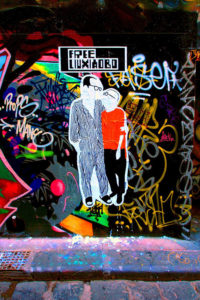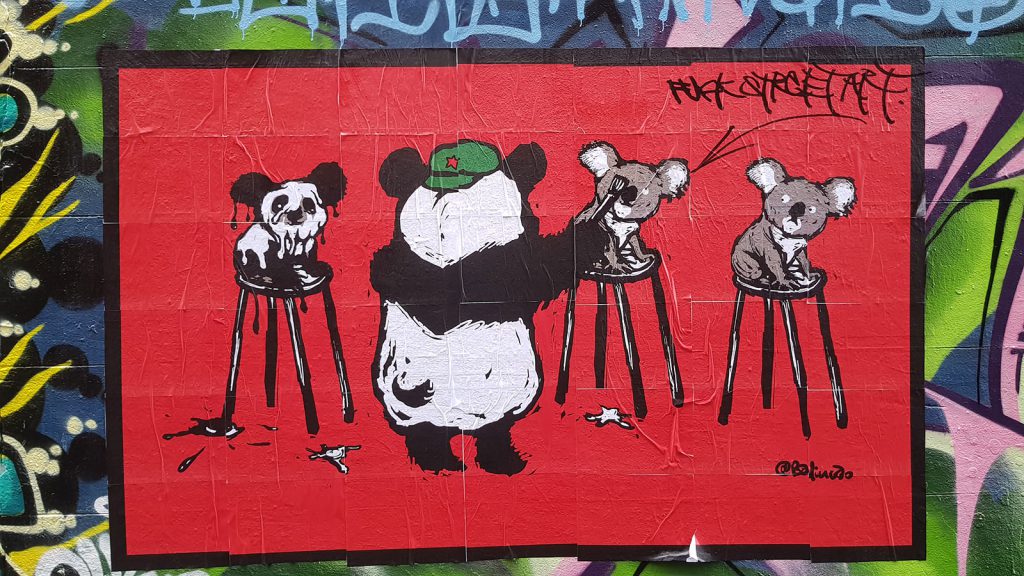
Badiucao’s portrait of Liu Xiaobo and Liu Xia in Hosier Lane, Melbourne
Photo: @badiucao, Twitter
In February, AsiaTOPA (the Asia–Pacific Triennial of Performing Arts) brought the National Ballet of China to the Melbourne Arts Centre to perform the Cultural Revolution propaganda ballet, ‘The Red Detachment of Women’ 红色娘子军. Off to one side, watching the opening night crowd file in, was the Shanghai-born grandson of a filmmaker who starved to death in one of Mao’s labour camps and whose family suffered greatly in the Cultural Revolution. An artist and cartoonist who goes by the pseudonym Badiucao 巴丢草, he wondered how it is possible that a democratic country such as Australia would so happily showcase what he considers an analogue to Nazi art. And he was not alone: one Melbourne critic likened the ballet to the spoof ‘Springtime for Hitler’ in Mel Brooks’s The Producers. Badiucao did not join the small protest on the night, taking a stand in his own way with cartoons of Mao singing into a microphone while sodomising a kangaroo and emu.
Badiucao paints and creates installation and performance art. His 2016 work Cancelled reflects on how the Chinese embassy returned his Chinese passport to him with one corner cut after he took Australian citizenship. The installation displays objects of personal and cultural identity including a laptop and Chinese spoon, each with a corner crisply excised. He has also turned a critical eye on his new country: Don Dale Play Group (also 2016) was a response to revelations about the abuse of Aboriginal youth in detention.
He is best known for his China-related cartoons and drawings, which draw inspiration from German Impressionism and woodblock printing — an aesthetic championed by early twentieth-century Chinese revolutionaries such as Lu Xun. In one cartoon, Xi Jinping hunches over a tub labelled #PanamaLeaks, laundering hundred-yuan bills; in another, a Mao-like cat catches a computer mouse — a comment on censorship.
Badiucao is adept at social media, with 29,100 Twitter followers alone at the time of writing. He regularly uploads cartoons and his stark portraits of Chinese human rights activists not only onto www.badiucao.com but also Google Drive for free download. Amnesty International, the BBC, and chinadigitaltimes.net have all republished his work.
In July 2017, Badiucao drew a double portrait of Liu Xiaobo and his wife Liu Xia, based on an official photograph of them when Liu was sick in hospital, and posted it in Melbourne’s graffiti-covered Hosier Lane. After Liu’s death, he added a second image of him ascending into heaven, with a halo on his head and his slippers discarded on the ground. The Hosier Lane site quickly became a shrine, with people leaving flowers and other offerings (see photo) and the images went viral. Because they are relatively abstract, activists in China briefly got away with posting them on the Internet.
The images have since appeared in public spaces around the world. Yet after the double portrait was reproduced on a Melbourne University campus wall, it quickly disappeared under a slew of posters for a Chinese-language website. Coincidentally or not, it also vanished not long after going up in Sydney University’s Graffiti Tunnel. During my interview with him, Badiucao expressed concern at the many ways that China is extending its power overseas, including in universities, where slurs such as ‘racist’ and ‘anti-China’ help to silence and control debate and criticism. He believes that social isolation makes Chinese students especially vulnerable to manipulation, and would like to see more social ‘inclusion’ as inoculation against a radical patriotism.
Badiucao does not sound paranoid when he says that Chinese agents and Internet sleuths are working hard to uncover his true identity: ‘I have been warned they are getting close’. They have trolled him relentlessly on social media from his first appearances on Weibo — a platform from which he’s now banned. Learning that he had studied to be a teacher, they fabricated stories about improper behaviour around children and created a fake website, badiucao.net, filled with slanderous content. (By August 2017, the fake site appeared to have been taken down.) Although an Australian citizen, he is worried enough about his job, personal safety, and family that he lives a double life — never making a public appearance without a mask of some kind. Until China itself becomes democratic and free, he says, the mask stays on.
Notes
Maxim Boon, ‘The Red Detachment of Women (Arts Centre, Melbourne)’, The Daily Review, 18 February 2017, online at https://dailyreview.com.au/red-detachment-women-arts-centre-melbourne/55965/
For a similar analysis, see Alexander Joske, ‘End the isolation of Chinese students in Australia’, The Sydney Morning Herald, 4 September 2017, online at http://www.smh.com.au/comment/end-the-isolation-of-chinese-students-in-australia-20170902-gy9iv6.html



